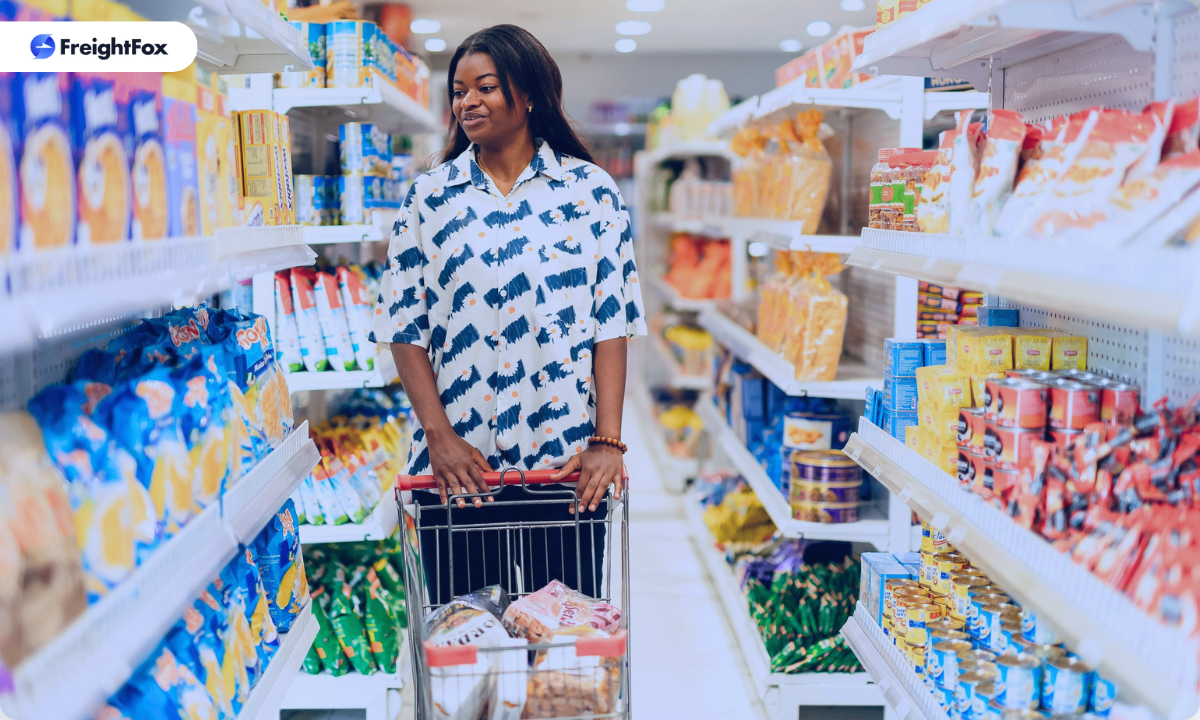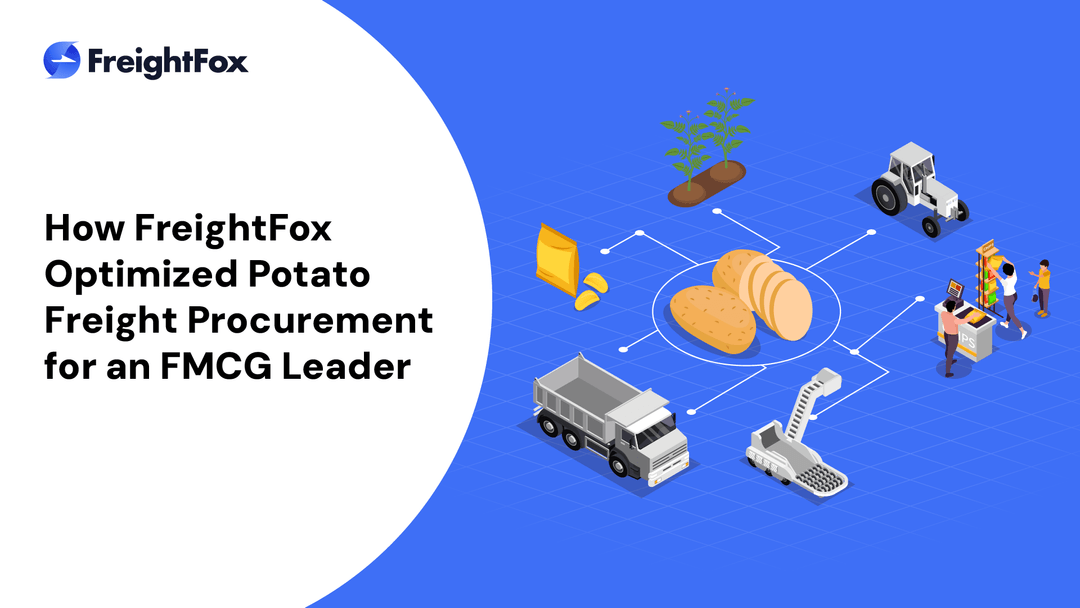
We live in a world where we take the conveniences afforded by technology for granted. For example, everything from our groceries to our favorite foods are delivered to our doorsteps in record time, all ordered by pushing a few buttons on our smartphones.
However, what we do not realize is that these deliveries are powered by a complex, high-speed logistics machine at work, and this machine needs to constantly adapt to changing demand trends, the vagaries of customer expectations and supply chain pressures.
Enter the world of FMCG logistics, a world that’s often invisible to the uninformed eye, but one that is fast moving and dynamic.
But for businesses, managing FMCG logistics is anything but simple. Every delay risks lost sales, product spoilage, and unhappy customers. With rising fuel costs, the e-commerce boom, and increasing focus on sustainability, the stakes have never been higher.
Managing FMCG logistics requires speed, precision, and adaptability. Every delay leads to lost revenue, missed opportunities, and frustrated customers. Rising fuel costs and changing consumer demands make it increasingly difficult to maintain smooth operations. The FMCG sector is on a rapid growth trajectory, projected to reach $220 billion by 2025, expanding at a 14.9% CAGR. This surge, driven by rural demand, digitalization, and sustainability trends, highlights the need for businesses to embrace technology-driven solutions to stay competitive.
The FMCG sector is influenced by many factors, like changing consumer preferences or digital adoption. Businesses need to stay ahead by adapting to these shifts and using technology to optimize their operations.
India’s economic landscape is shifting, reshaping the traditional income pyramid into a diamond-shaped structure. With rising disposable incomes, consumers are increasingly prioritizing premium personal care, home care, and wellness products, driving demand for high-quality, specialized offerings that require advanced supply chain solutions.
E-commerce is transforming FMCG logistics, pushing brands to adapt to faster, more responsive supply chains. AI-driven insights help companies personalize marketing and predict demand, but the real challenge lies in fulfillment.
The rise of quick commerce platforms like Blinkit and Swiggy Instamart has intensified the need for hyper-efficient warehousing. To meet consumer expectations for instant availability, this also requires real-time inventory management and rapid last-mile delivery.
Consumers are prioritizing natural, organic, and wellness-focused products. These categories require temperature-controlled storage, careful handling, and faster replenishment cycles. Maintaining quality and service simultaneously appears to be a challenge for FMCG logistics.
Direct-to-consumer (D2C) brands are affecting FMCG logistics by demanding faster fulfillment, streamlined warehousing, and hyper-local distribution. To stay competitive, they must adapt supply chains for speed, flexibility, and direct customer engagement.
FMCG brands need intelligent logistics solutions to stay ahead. FreightFox offers AI-driven visibility and predictive analytics, helping businesses streamline supply chains, reduce costs, and improve delivery performance.
Also Read: Supply Chain Lead Time Reduction: Key Benefits & Effective Strategies
An efficient supply chain is the backbone of successful FMCG logistics. It ensures the right products reach the right locations at the right time, helping companies stay ahead of consumer demand and market fluctuations.
Maximized Sales Opportunities – Timely stock replenishment keeps shelves full and sales flowing, ensuring that businesses never miss a revenue opportunity
Optimized Inventory Costs – With precise demand forecasting and inventory control, companies can maintain just the right stock levels, reducing warehousing and handling expenses
Maintained Product Quality – A fast, responsive supply chain is critical for moving perishable goods quickly, preserving freshness and reducing waste
Meeting Modern Customer Expectations – An efficient supply chain supports rapid fulfillment and real-time availability, aligning with the instant delivery expectations of online and quick commerce platforms
FMCG logistics is a high-speed, high-stakes environment where even minor delays can lead to major consequences. Efficient logistics is not just a backend operation, it’s a core business enabler that impacts sales, customer loyalty, and brand credibility.
As Vinay Dhanani, COO of Zepto, puts it:
"Companies with the ability to forecast closer to the consumption, better lead times, and the agility to update supply chain models and respond quickly to the change in demand will survive and will always have an advantage over competitors."
This quote reflects the intensity of today’s logistics landscape, where supply chain agility directly influences business outcomes. Below are the critical challenges FMCG companies must navigate:
Consumer tastes change rapidly, influenced by lifestyle shifts, health trends, and seasonal demand. New product launches and promotions add further volatility. Companies must move from reactive forecasting to real-time demand sensing to stay ahead.
FMCG supply chains involve multiple layers—from suppliers and manufacturers to regional warehouses and last-mile delivery partners. Keeping this ecosystem synchronized requires advanced planning, visibility, and coordination.
Unpredictable weather, from monsoon floods to heatwaves, frequently disrupts transportation and inventory flow. Platforms like Freight IQ by FreightFox help anticipate these disruptions and reroute shipments efficiently using real-time data and analytics.
While urban consumers seek premium, fast-moving products with same-day delivery, rural buyers prioritize affordability and availability. Serving both segments demands parallel logistics strategies that are tailored and scalable.
With shorter product life cycles, FMCG brands must constantly adapt manufacturing and distribution. Outdated stock results in waste, while delays in launching trending products can cost market share.
Sustainability is no longer optional. FMCG companies are under pressure to reduce emissions, cut down on plastic packaging, and source responsibly. FreightFox’s Freight Sustainability tool enables companies to lower their carbon footprint without compromising operational efficiency.
Evolving trade policies, GST compliance, and environmental regulations create frequent changes in supply chain protocols. Logistics strategies must remain compliant while adapting swiftly across geographies.
While digital solutions such as WMS and AI-powered planning tools promise better control and efficiency, fragmented infrastructure often makes integration complex. Building end-to-end digital connectivity remains a work in progress for many FMCG brands.
Also Read: FMCG Logistics and Distribution: How to Speed Up Your Supply Chain
To effectively handle your FMCG logistics, you need smart, agile strategies to stay ahead. Here’s how you can streamline your logistics smoothly:
FMCG companies must adopt flexible supply chain models that allow quick responses to market shifts. Agile processes help businesses manage demand surges, prevent stockouts, and reduce wastage by continuously adjusting production and distribution based on real-time insights.
Automation, AI-driven analytics, and IoT-enabled tracking systems make logistics faster and more precise. These tools improve route planning, enhance inventory visibility, and ensure timely replenishment, ultimately reducing costs and improving service levels.
Integrated Warehouse Management Systems (WMS) and Supply Chain Management (SCM) solutions streamline inventory control, automate order fulfillment, and enhance tracking. These systems improve accuracy, reduce delays, and ensure seamless operations across storage and transportation networks.
FMCG companies can improve planning and inventory replenishment by working closely with retailers through unified tech platforms. This ensures real-time data sharing, better stock availability, and more efficient order management, reducing waste and enhancing on-shelf product availability.
Using real-time consumer data, companies can predict trends and adjust supply chain strategies accordingly. Demand sensing helps businesses minimize overproduction, reduce stockouts, and ensure that the right products are available when and where needed.
AI and machine learning enable accurate demand forecasting, which helps FMCG companies align production schedules with actual market needs. This minimizes waste, optimizes distribution networks, and ensures products reach consumers on time without unnecessary stockpiling.
Here ‘s an example of some of these best practices at work:
ITC Ltd., one of India’s largest FMCG companies, has made significant strides in enhancing logistics efficiency through strategic use of technology. As part of its supply chain transformation, ITC has integrated digital tools to ensure speed, visibility, and flexibility across its vast distribution network.
The company leverages real-time data and predictive analytics to streamline inventory management and optimize replenishment cycles. This helps ITC forecast demand more accurately and reduce the risk of stockouts or overstocking, especially in fast-moving categories like packaged foods and personal care products.
ITC has also deployed automated systems for order processing and warehouse operations, enabling quicker turnaround times and reducing manual errors. Its adoption of route optimization technologies ensures timely deliveries, even in remote or high-demand regions. These solutions are especially effective in states like Kerala, where diverse geographies and consumer preferences require agile and region-specific logistics planning.
Also Read: A Guide to Freight Distribution Management

Let's explore a real-life example highlighting how FreightFox helped a leading FMCG company through strategic commodity flow analysis.
A ₹9,000 Cr FMCG player was losing money and time trying to move one thing right, potatoes.
Core issues:
What FreightFox Did:
Outcome:
FreightFox didn’t just save money, they made potato logistics predictable, even when the agri market wasn’t.
The FMCG sector’s rapid growth demands an agile, cost-effective, and technology-driven logistics strategy. Businesses that optimize freight movement, enhance visibility, and proactively address supply chain disruptions will stay ahead in a competitive market.
Solutions like Freight Manage provide seamless control over daily freight operations, helping businesses optimize contract allocation, minimize inefficiencies, and cut transportation costs. Freight IQ delivers real-time supply chain intelligence, enabling data-driven decisions that improve resilience and operational efficiency.
By integrating these smart freight solutions, FMCG companies can reduce costs, improve supply chain transparency, and ensure reliable product movement, keeping pace with an ever-evolving industry.
FreightFox empowers businesses with data-driven logistics solutions. Partner with us to transform your freight operations!